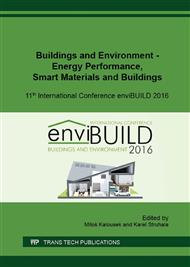[1]
B. Blocken, J. Carmeliet, A review of wind-driven rain research in building science, Journal of Wind Engineering and Industrial Aerodynamics, 92 (2004) p.1079–1130.
DOI: 10.1016/j.jweia.2004.06.003
Google Scholar
[2]
A. Kubilay et al., CFD simulation and validation of wind-driven rain on a building facade with an Eulerian multiphase model, Build. Environ., 61 (2013) p.69–81.
DOI: 10.1016/j.buildenv.2012.12.005
Google Scholar
[3]
M. Bielek et al., Konštrukcie pozemných stavieb IV: Problémy aerodynamiky a hydrodynamiky v teórii konštrukčnej tvorby budov, Alfa, Bratislava, (1984).
Google Scholar
[4]
STN EN 15026: 2007 – Hygrothermal performance of building components and building elements – Assessment of moisture transfer by numerical simulation. European Committee for Standardization, Brussels, (2007).
DOI: 10.3403/30124008u
Google Scholar
[5]
STN EN ISO ISO 15927-3: 2009 - Hygrothermal performance of buildings - Calculation and presentation of climatic data - Part 3: Calculation of a driving rain index for vertical surfaces from hourly wind and rain data, International Organization for Standardization, Geneve, (2009).
DOI: 10.3403/30142062u
Google Scholar
[6]
Information on http: /wufi. com.
Google Scholar
[7]
BS 8104: 1992-Code of practice for assessing exposure of walls to wind-driven rain, BSI, (1992).
Google Scholar
[8]
Information on www. shmu. sk.
Google Scholar
[9]
B. Blocken, J. Carmeliet, On the accuracy of wind-driven rain measurements on buildings, Build. Environ., 12 (2006) pp.1798-1810.
DOI: 10.1016/j.buildenv.2005.07.022
Google Scholar
[10]
P. Juras, Measurement and CFD simulation of wind-driven rain using eulerian multiphase model, Advanced Materials Research, 1041 (2014) pp.265-268.
DOI: 10.4028/www.scientific.net/amr.1041.265
Google Scholar
[11]
O. Koronthalyova, P. Matiasovsky, Driving rain course simulation based on daily data, Journal of Thermal Env. & Bldg. Sci., 7 (2001) pp.51-66.
Google Scholar
[12]
J. Franke et al., The cost 732 best practice guideline for CFD simulation of flows in the urban environment: a summary, International Journal of Environment and Pollution, 1-4 (2011) pp.419-427.
DOI: 10.1504/ijep.2011.038443
Google Scholar
[13]
Information on www. openfoam. org.
Google Scholar
[14]
A.C. Best, The size distribution of raindrops, QJR Meteorological Soc., 76 (1950) pp.16-36.
Google Scholar
[15]
P. Juras, P. Kajaba, V. Horecka, Analýza klimatických údajov pri tvorbe referenčného roka pre Bratislavu, Meteorologický časopis / Meteorological Journal, 16 (2013) pp.21-25.
Google Scholar
[16]
P. Juras, J. Zilinsky, Measurements of wind-driven rain absorptivity of various coatings in rain chamber, ATF 2013: 2nd Conference on Acoustics, Light and Thermal Physics in Architecture and Building Structures, Katholieke Universiteit Leuven, Leuven, 2013, pp.78-84.
Google Scholar
[17]
M. Abuku et al., Impact, absorption and evaporation of raindrops on building facades, Build. Environ, 44 (2009) pp.113-124.
DOI: 10.1016/j.buildenv.2008.02.001
Google Scholar
[18]
P. Juras, P. Durica, Influence of wind-driven rain on the thermal conductivity of building envelopes with different cement-lime coatings, Communications: scientific letters of the University of Zilina, 4 (2016) pp.74-80.
DOI: 10.26552/com.c.2014.4.74-80
Google Scholar


